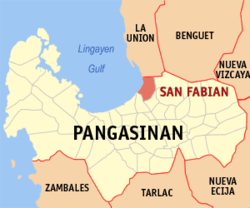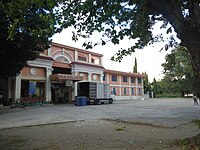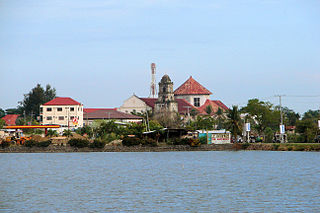
Binmaley, officially the Municipality of Binmaley, is a 1st class municipality in the province of Pangasinan, Philippines. According to the 2020 census, it has a population of 86,881 people.
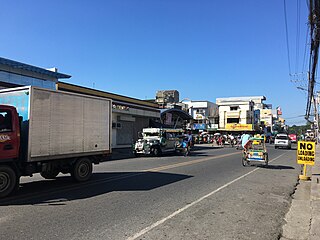
Mangaldan, officially the Municipality of Mangaldan, is a 1st class municipality in the province of Pangasinan, Philippines. According to the 2020 census, it has a population of 113,185 people.

Anda, officially the Municipality of Anda, is a 3rd class municipality in the province of Pangasinan, Philippines. Unique in this part of the province, The Sambalic language of Bolinao or Binubolinao is primarily spoken in the municipality and the adjacent town of Bolinao. According to the 2020 census, it has a population of 41,548 people.

Sison, officially the Municipality of Sison, is a 3rd class municipality in the province of Pangasinan, Philippines. The town's original name was Alava. According to the 2020 census, it has a population of 52,320 people.
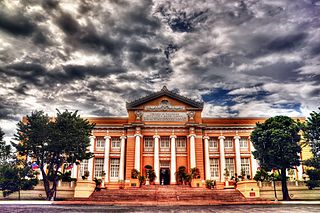
Pangasinan, officially the Province of Pangasinan, is a coastal province in the Philippines located in the Ilocos Region of Luzon. Its capital is Lingayen. Pangasinan is in the western area of Luzon along Lingayen Gulf and the South China Sea. It has a total land area of 5,451.01 square kilometres (2,104.65 sq mi). According to the 2020 census, it has a population of 3,163,190. The official number of registered voters in Pangasinan is 1,651,814. The western portion of the province is part of the homeland of the Sambal people, while the central and eastern portions are the homeland of the Pangasinan people. Due to ethnic migration, the Ilocano people settled in the province.
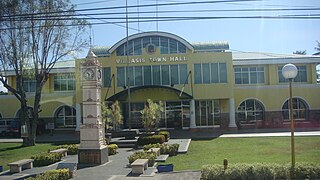
Villasis, officially the Municipality of Villasis, is a 1st class municipality in the province of Pangasinan, Philippines. According to the 2020 census, it has a population of 65,047 people.

Rosario, officially the Municipality of Rosario, is a 1st class municipality in the province of La Union, Philippines. According to the 2020 census, it has a population of 60,278 people.

Bani, officially the Municipality of Bani, is a 2nd class municipality in the province of Pangasinan, Philippines. According to the 2020 census, it has a population of 52,603 people.

Basista, officially the Municipality of Basista, is a 4th class municipality in the province of Pangasinan, Philippines. According to the 2020 census, it has a population of 37,679 people.

Bautista, officially the Municipality of Bautista, is a 4th class municipality in the province of Pangasinan, Philippines. According to the 2020 census, it has a population of 35,398 people.

Calasiao, officially the Municipality of Calasiao, is a 1st class municipality in the province of Pangasinan, Philippines. According to the 2020 census, it has a population of 100,471 people.

Labrador, officially the Municipality of Labrador, is a 4th class municipality in the province of Pangasinan, Philippines. According to the 2020 census, it has a population of 26,811 people.

Lingayen, officially the Municipality of Lingayen, is a 1st class municipality and capital of the province of Pangasinan, Philippines. According to the 2020 census, it has a population of 107,728 people.
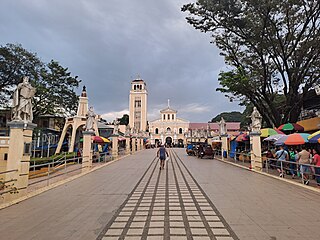
Manaoag, officially the Municipality of Manaoag, is a 1st class municipality in the province of Pangasinan, Philippines. According to the 2020 census, it has a population of 76,045 people.

Mapandan, officially the Municipality of Mapandan, is a 3rd class municipality in the province of Pangasinan, Philippines. According to the 2020 census, it has a population of 38,058 people.
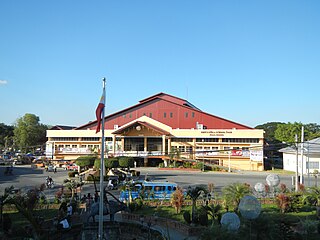
Rosales, officially the Municipality of Rosales, is a 1st class municipality in the province of Pangasinan, Philippines. According to the 2020 census, it has a population of 66,711 people.

San Jacinto, officially the Municipality of San Jacinto, is a 3rd class municipality in the province of Pangasinan, Philippines. According to the 2020 census, it has a population of 44,351 people.

Sual, officially the Municipality of Sual, is a 1st class municipality in the province of Pangasinan, Philippines. According to the 2020 census, it has a population of 39,091 people.

Umingan, officially the Municipality of Umingan, is a 1st class municipality in the province of Pangasinan, Philippines. According to the 2020 census, it has a population of 77,074 people.
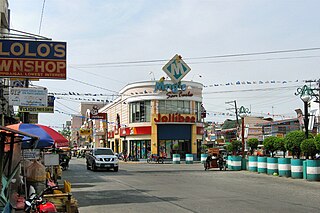
San Carlos, officially the City of San Carlos, is a 3rd class component city in the province of Pangasinan, Philippines. According to the 2020 census, it has a population of 205,424 people. It is the most populated city in Pangasinan and the entire Ilocos Region.

